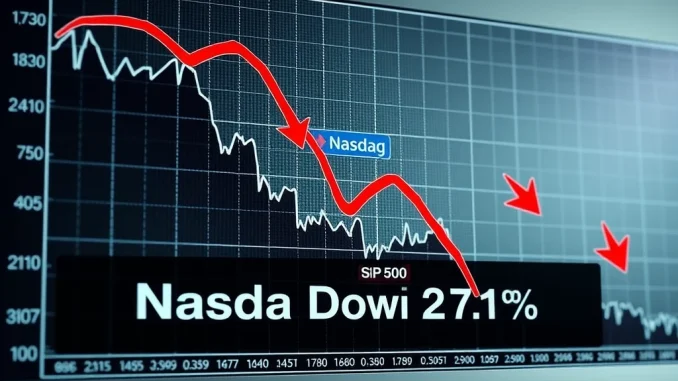
Urgent Alert for Investors! Are you watching the market today? If you’re involved in crypto or any investment linked to traditional markets, you need to pay close attention. Today’s intraday trading session is sending shockwaves as the Nasdaq composite index experiences a significant downturn. Let’s dive into what’s happening and what it could mean for your investments.
Why is the Nasdaq Experiencing a Sharp Intraday Trading Downturn?
Today’s market action is painting a concerning picture. The Nasdaq, a tech-heavy index often seen as a barometer for growth and innovation, is currently down by a substantial 2.71% in intraday trading. This isn’t happening in isolation. The broader stock market is feeling the pressure too. Here’s a quick snapshot:
- Nasdaq Composite: Down 2.71%
- S&P 500: Down 2.00%
- Dow Jones Industrial Average: Down 1.72%
These are significant drops, especially within a single trading day. But what’s fueling this market downturn? Several factors could be at play:
- Economic Data Concerns: Recent economic indicators might be raising red flags. This could include inflation figures, jobs reports, or consumer spending data that are weaker than expected, suggesting a potential slowdown.
- Interest Rate Hikes Anticipation: The market is highly sensitive to interest rate expectations. If there are signals suggesting more aggressive interest rate hikes from central banks to combat inflation, it can trigger a stock sell-off. Higher interest rates make borrowing more expensive for companies and can reduce future earnings expectations, making stocks less attractive.
- Geopolitical Uncertainty: Global events and geopolitical tensions always add a layer of uncertainty. Any escalation in these areas can lead investors to pull back from riskier assets like stocks.
- Profit Taking and Market Correction: After periods of market gains, investors sometimes engage in profit-taking, selling off stocks to secure gains. This can sometimes trigger a broader market downturn, especially if combined with other negative catalysts.
Intraday Trading Volatility: What Does a 2.71% Nasdaq Drop Mean?
A 2.71% drop in the Nasdaq during intraday trading is not a minor fluctuation. It signals a significant shift in investor sentiment within a single day. Here’s why this level of volatility is noteworthy:
- Increased Fear and Uncertainty: Large intraday drops often breed fear in the market. Investors may become more risk-averse, leading to further selling pressure.
- Potential for Margin Calls: For traders using leverage, significant intraday trading losses can trigger margin calls, forcing them to sell assets to cover their positions, which can exacerbate the downward pressure.
- Indicator of Broader Weakness: The Nasdaq, with its focus on technology and growth stocks, is often seen as a leading indicator for the overall health of the stock market. A sharp drop here can signal broader economic concerns and potential weakness across different sectors.
Is This a Buying Opportunity or a Reason to Panic in the Stock Market?
This is the million-dollar question on every investor’s mind during a stock sell-off. Is this a temporary dip, a chance to buy quality stocks at lower prices, or the start of a deeper, more prolonged market downturn? There’s no easy answer, and it depends heavily on your individual investment strategy, risk tolerance, and long-term outlook.
Potential Buying Opportunity?
- Long-Term Perspective: If you are a long-term investor, stock market dips can present opportunities to buy into strong companies at discounted prices. If you believe in the long-term growth potential of the companies affected, this could be a chance to accumulate more shares.
- Fundamental Strength: Focus on companies with strong fundamentals – solid balance sheets, healthy cash flow, and a history of profitability. A market downturn can sometimes indiscriminately drag down even fundamentally sound stocks, creating buying opportunities.
- Dollar-Cost Averaging: Consider dollar-cost averaging – investing a fixed amount of money at regular intervals, regardless of the market price. This strategy can help you take advantage of lower prices during dips and reduce the risk of trying to time the market bottom.
Reasons for Caution?
- Uncertainty Remains: It’s crucial to acknowledge that the reasons behind the stock sell-off might persist or even worsen. Economic data could deteriorate further, interest rates could rise more than anticipated, or geopolitical risks could escalate.
- Potential for Further Declines: Market downturns can sometimes be prolonged. It’s possible that this is just the beginning of a larger correction.
- Risk Management is Key: Now is the time to review your portfolio’s risk exposure. Ensure your asset allocation aligns with your risk tolerance and investment goals. Consider diversifying your portfolio to mitigate risk.
Actionable Insights During This Market Downturn
Navigating a market downturn requires a calm and informed approach. Here are some actionable insights:
- Stay Informed: Keep a close watch on market news and economic data releases. Understand the factors driving the current stock sell-off.
- Review Your Portfolio: Assess your portfolio’s performance and risk exposure. Identify areas that might be particularly vulnerable in a market downturn.
- Don’t Panic Sell: Emotional decisions are often detrimental in investing. Avoid impulsive selling based on fear. Stick to your long-term investment plan.
- Consider Rebalancing: If your portfolio has become misaligned with your target asset allocation due to market movements, consider rebalancing to bring it back in line.
- Seek Professional Advice: If you are unsure how to navigate the current market conditions, consult with a qualified financial advisor.
Conclusion: Navigating the Intraday Trading Storm
The Nasdaq’s 2.71% intraday drop, alongside declines in the S&P 500 and Dow, is a stark reminder of the inherent volatility of the stock market. While market downturns can be unsettling, they also present potential opportunities for informed investors. By staying calm, informed, and focused on your long-term investment goals, you can navigate these turbulent times and position yourself for future success. Remember, market fluctuations are a normal part of the investment journey. Focus on understanding the underlying factors, managing your risk, and making rational decisions rather than emotional ones.



